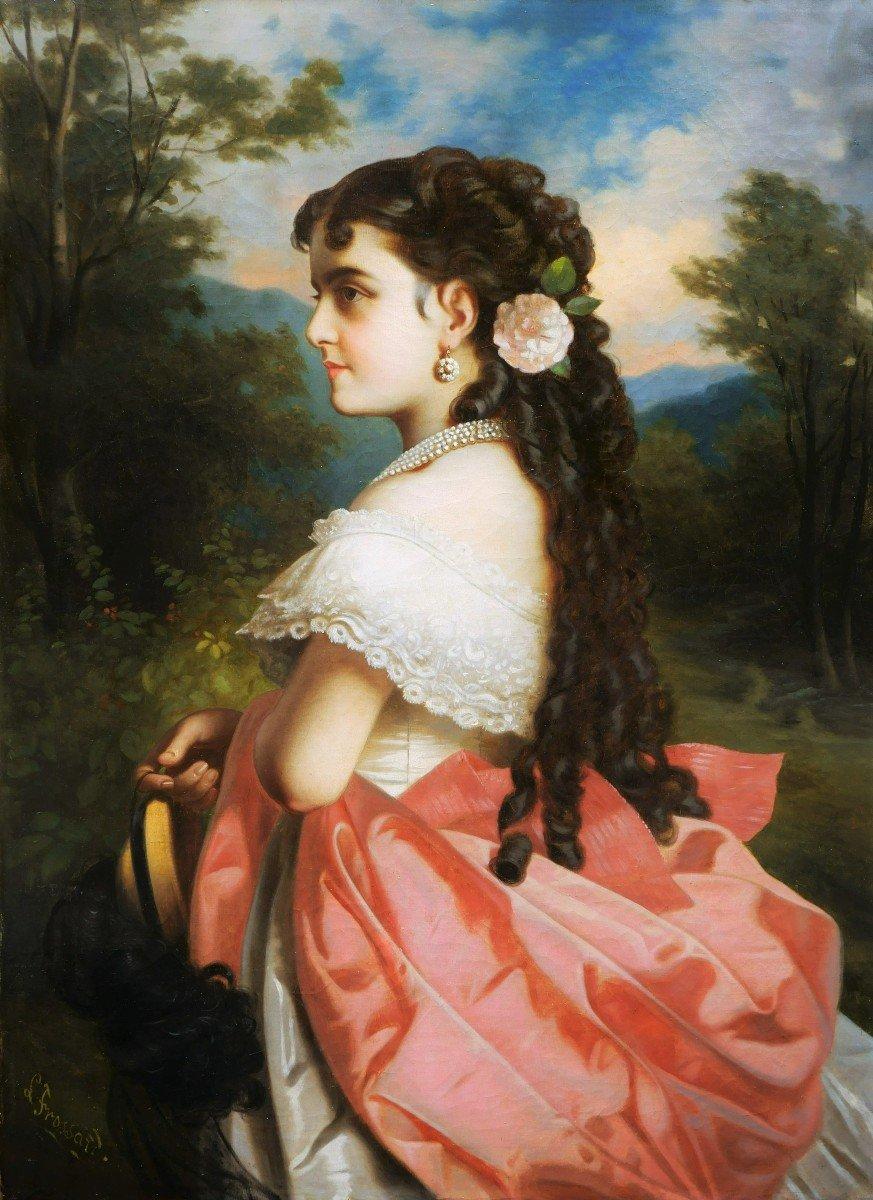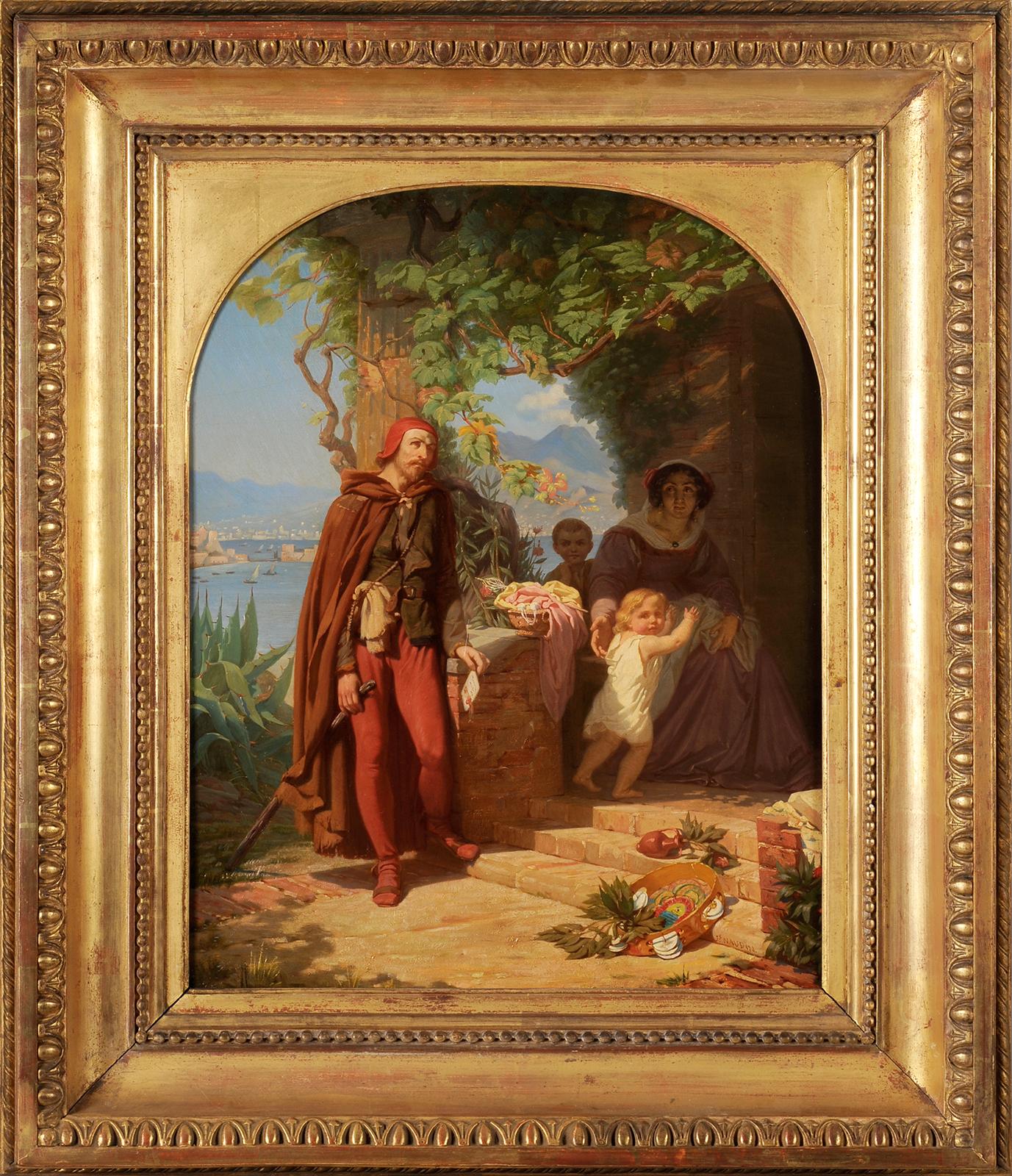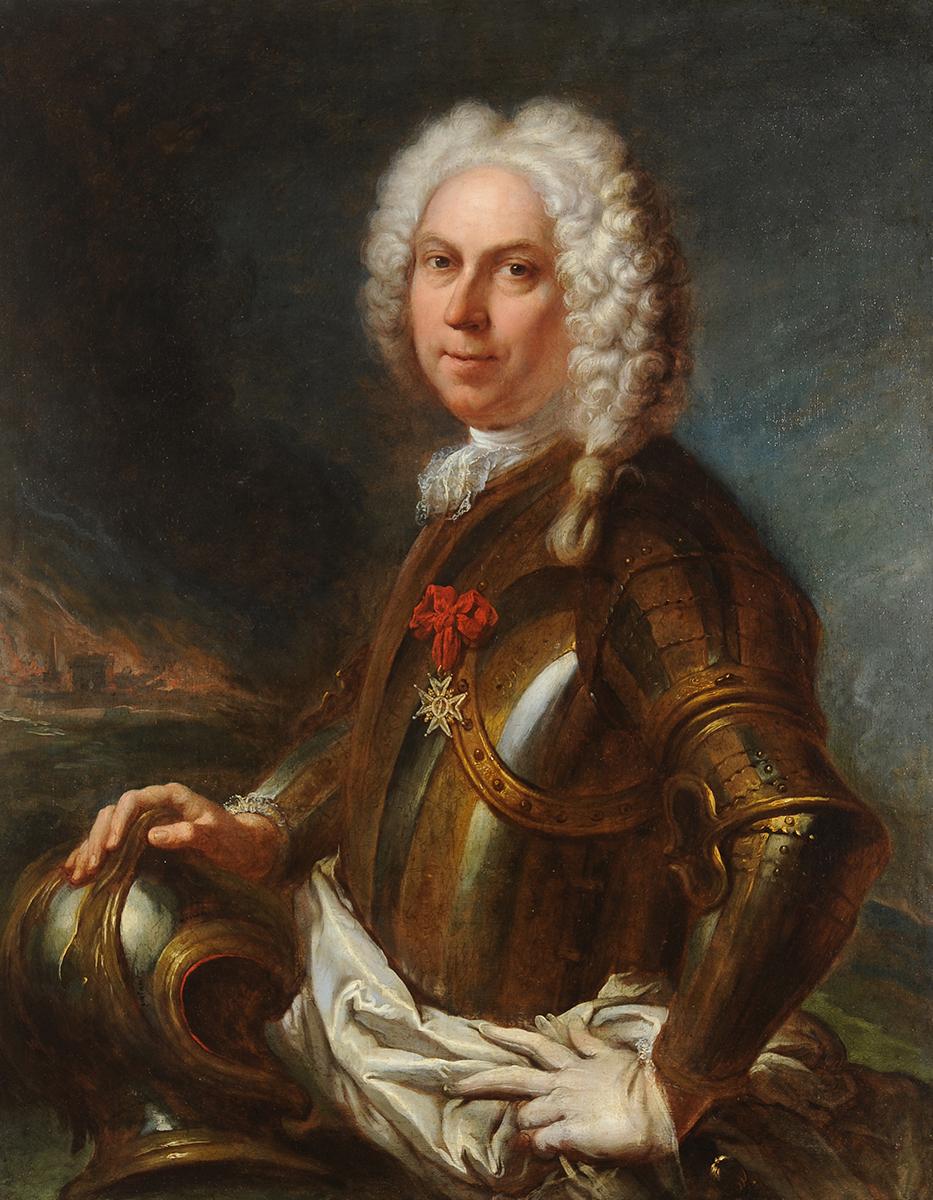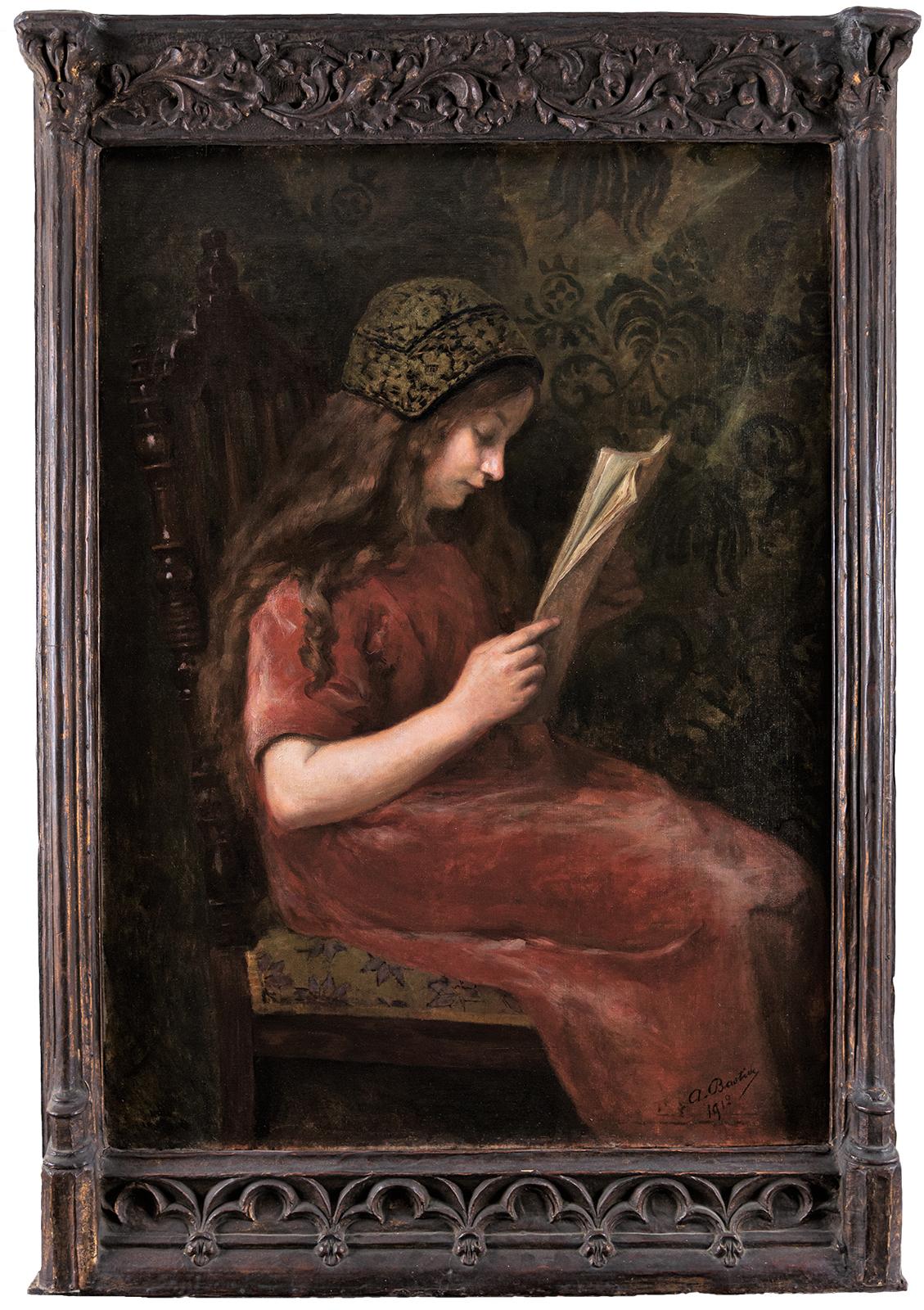Items Similar to Diana Bathing 18th Century Oil on Canvas by Friedrich Olenhanz 1765-1839
Want more images or videos?
Request additional images or videos from the seller
1 of 7
FRIEDRICH OELENHAINZ ENDINGENDiana Bathing 18th Century Oil on Canvas by Friedrich Olenhanz 1765-18391789
1789
About the Item
"As the incarnate of dawn shines in the morning, such a blushed Diane's complexion exposed without veils to the eyes of a mortal" Les Métamorphoses by Ovide
Less tragic is our destiny than that of Acteon who, having surprised the goddess Diane in the bath, is transformed into a deer and devoured by her own dogs before the eyes of her companions.
Despite the imminent drama, it is under his delicate brush, moved by an impudent eye, that Friedrich Olenhanz makes his composition a charming object of contemplation. A painter at the Vienna court, a portraitist of the Liechtenstein family and the court, he mixes with his first talent that of the performance of a mythological episode. Here, the singular features of the goddess suggest the true face that inspired them and that could be that of Caterina Odescalchi "As the incarnate of the dawn shines in the morning, such a blushed the complexion of Diana exposed without veils to the eyes of a mortal" Ovid, Les Métamorphoses (1765 - 1839), Countess of Bracciano, Sirmio and Ceri. Known by Oelenhainz, he had not long before painted a portrait of the young woman, represented at the middle of his body, with his head girded with a beaded ribbon and dressed in a yellow dress.
But here with charm, the painter exceeds the conventions of classical portraiture by contextualizing the model against the background of mythological narrative. Clearing herself from dark skins, the pudically striped young goddess hangs her gesture, the rose rising to her cheeks as we break the sacredness of the place. The presence of other nymphs remains anecdotal and our attention is focused on the body highlighted by the goddess. This is offered in a setting of red and white draperies, echo the shades chosen for its flesh and from which emanates all the brightness of the painting.
Admitted to the Academy of Fine Arts in Vienna in 1789, Oelenhainz exhibited this work at the Salon of 1789, when it was in the collection of a Count Überacker before it was engraved ten years later by a certain Traunfellner (picture 2). The engraving mentions a dedication to Prince Charles-Philippe of Schwarzenberg (1771-1820) for reasons that remain unknown to us. Would the painting as the engraving be only witnesses of relations of which they are no longer than distant echoes?
- Creator:FRIEDRICH OELENHAINZ ENDINGEN (1765 - 1839, Austrian)
- Creation Year:1789
- Dimensions:Height: 24.41 in (62 cm)Width: 19.49 in (49.5 cm)Depth: 1.97 in (5 cm)
- Medium:
- Movement & Style:
- Period:
- Condition:
- Gallery Location:LA BOUILLE, FR
- Reference Number:1stDibs: LU1808211359062
About the Seller
No Reviews Yet
Vetted Seller
These experienced sellers undergo a comprehensive evaluation by our team of in-house experts.
Established in 1998
1stDibs seller since 2022
- ShippingRetrieving quote...Ships From: LA BOUILLE, France
- Return PolicyA return for this item may be initiated within 3 days of delivery.
More From This SellerView All
- Wonderful Portrait of exceptional qualityLocated in LA BOUILLE, FRLouis Felix Amiel 1802-1864. Ecole national superieure des Beaux Arts. This painting signed bottom left is of exceptional quality resembles the playwright Charles Theodore Cogniard t...Category
Mid-19th Century French School Portrait Paintings
MaterialsCanvas, Oil
- A portrait of a young man 19th century oil on canvasLocated in LA BOUILLE, FRCharles Gustave, Baron Wappers (23 August 1803 in Antwerp - 6 December 1874 in Paris) was a Belgian painter, also known by his Flemish name, under which he signed his works, Egidius Karel Gustaaf or Gustaf Wappers. He was introduced to the art of painting at the academy of painting in Antwerp where he was a student of Guillaume Herreyns and Mathieu-Ignace van Brée, his trip to Paris in 1826 allowed him to introduce the Romantic movement, then essentially French, into the future kingdom of Belgium. He was successively made commander of the orders of Leopold and Christ (in Portugal), Grand Cross...Category
Mid-19th Century French School Portrait Paintings
MaterialsCanvas, Oil
- "Maternity" by Jose Royo 20th century oil on Board SignedBy José RoyoLocated in LA BOUILLE, FR"The Maternity" by Jose Royo oil on board. Oil on board Jose Royo's "The Maternity." Even in its small frame, this powerful painting packs a big punch becau...Category
Late 20th Century Modern Portrait Paintings
MaterialsOil, Board
- The Great Fire of Rome AD64Located in LA BOUILLE, FRAn amazing 19th century view of Capitoline Hill Rome before and during the Great Fire of Rome AD64 destroying 2 thirds of the city. This is a rare a...Category
1880s French School Landscape Drawings and Watercolors
MaterialsWatercolor
- Porteur D'eau by Joseph GulucheLocated in LA BOUILLE, FRA 19th century terracotta statue of a North African carrying water by Joseph Le Guluche. The subjects of Joseph Le Guluche have a great presence, always very expressive, often in mo...Category
1890s Other Art Style Figurative Sculptures
MaterialsTerracotta
- Pair of Terracotta Nubiens probably GoldsheiderLocated in LA BOUILLE, FRAn exquisite set of a pair of North African orientalist/africanist terracotta sculptures of a man and female conveying water containers. Most likely by Goldsheider, incredibly molded...Category
Late 19th Century Still-life Sculptures
MaterialsTerracotta
You May Also Like
- Woman with Lobsters / "Femme et Homards"By Andre MinauxLocated in Berlin, MDAndre Minaux (French 1923 - 1986) "Femme et Homards" / Woman with Lobsters. Oil on canvas. Features a young woman holding one lobster while two others sit on a counter before her. ...Category
Mid-20th Century French School Portrait Paintings
MaterialsCotton Canvas, Oil
- Portrait of singer Adelina Patti - L. Frossard - OperaLocated in BELEYMAS, FRL. FROSSARD (active in Vienna around 1870) Portrait of Adelina Patti (1843-1919) Oil on canvas H. 100.5 cm; L. 73.5 c Signed lower left If the artist maintains a certain discretion ...Category
1860s French School Figurative Paintings
MaterialsCanvas, Oil
- Jules Naudin (1817-c.1876) - Tasso arriving at his sister's house in SorrentoBy Attilio ManganaroLocated in BELEYMAS, FRJules Ambroise Francois NAUDIN (Paris 1817 – c.1876) Tasso arriving at his sister's house in Sorrento Oil on canvas H. 49 cm; L. 37.5 cm Signed lower right Exhibition: 1852, Paris Salon, under number 959 Related work: Engraving by Jean-Denis Nargeot in 1852 Bibliography: L’Illustration, April 24, 1852, engraved by Best, Hottelin and Regnier, after a drawing by Valentin) and reproduced p.260, cited p.262; La Mode: Political, Religious and Literary Review, 1852, quoted; Journal des Demoiselles...Category
1850s French School Figurative Paintings
MaterialsCanvas, Oil
- Model undressingLocated in BELEYMAS, FRJulius EXNER (Copenhagen, 1825 - Copenhagen, 1910) Model stripping Oil on canvas H. 122 cm; L. 74 cm Signed and dated 1842 lower right Exhibition: most likely Charlottenborg Salon of 1845, under number 110, titled Modelfigur, awarded with a silver medal Provenance: Emilio Fernando Bolt (c.1860 - 1944), acquired from the artist around 1900, then by descent Our painting was produced as part of the summer sessions organized between 1839 and 1850 by Christoffer Wilhelm Eckersberg (1783-1853), the master of Danish painting of the first half of the 19th century, in his private studio-apartment on the ground floor. floor at the Royal Academy of Fine Arts in Copenhagen. The master brought together a few students there between June and September, rented one or two models for the season, which were painted from different angles, the artists (including Eckersberg himself) sitting side by side. Eckersberg used to paint a fairly small version, the pupils of the larger formats. The work fits more generally into the legendary context of the research and reforms carried out by Eckersberg concerning the studies of nudes and in particular of female nudes, to make this exercise a genre of painting in its own right. Following his two-year stint in Jacques-Louis David's studio in Paris in 1811, Eckersberg had been made aware of work on the nude and in particular on live models, in natural light, while in Denmark the drawings were then only made from casts of antique models or other mannequins. In 1822, when he had been a professor there since 1818, it was he who had the Royal Academy of Copenhagen authorize the study of nudes, no longer in the evening by candlelight, but in natural light; from 1833, it was still he who allowed students to work on nude female models, even if the official authorization of the Academy did not take place until 1839. It was this same year that he instituted his summer sessions, on a private basis, to orient his painting and that of his students towards a new conception of the representation of models: even if the nude remains the real theme, it does not however, this is more than just an academic exercise. The subject is placed in a contemporary interior, with a rather sophisticated decor, and occupied with an intimate activity (it is this type of intimate vein that we will find later in Degas or Cassatt for example); thus in our painting, the young woman is supposed to take off her clothes to wash. The objective is that the viewer forgets that the master and his students are painting a model during a posing session, and that he instead has the impression of being alone with the model, but invisible, almost like a voyeur in spite of himself. Moreover, in these paintings, the model never looks towards the spectator, inducing a psychological distance with him, whereas model and artist are actually physically very close. On the other hand, it is not a question of idealized nudes either, even if Eckersberg, proof of his debt to the antique, chooses fairly classic models and poses. The sensuality is real and very present, with dreamy, even innocent, and timeless expressions (the models do not seem to have a defined age), suave and slow attitudes and movements, and especially with clothes that hide or reveal skillfully parts of the female body: upper buttocks, pronounced hips... Made by an artist under 20, our sensual painting is probably one of the most beautiful and spectacular produced by the students of Eckersberg during these summer sessions. With a perfect balance between the firmness of an ancient statue (it recalls the Venus de Milo) and the softness of the feminine forms, highlighted by a harmonious palette, it captures the attention with many details: the almost photographic folds white clothing...Category
1840s French School Nude Paintings
MaterialsCanvas, Oil
- Portrait of a man in armorLocated in BELEYMAS, FRAttributed to Jacques DUMONT aka DUMONT LE ROMAIN (Paris 1701 - 1781) Presumed portrait of Louis-Joseph de Formanoir (?-1732) Oil on canvas H. 91.5 cm; ...Category
1750s French School Figurative Paintings
MaterialsCanvas, Oil
- Young girl readingLocated in BELEYMAS, FRAlice BASTIDE (Saint Mandé 1868 – Paris 1959) Portrait of a little girl reading Oil on canvas H. 100 cm; L. 72.5 cm Signed lower right and dated 1912 Daughter of a pastor from Gard and an English woman, Alice Bastide grew up in Paris. A pupil of the Jullian Academy, she began her apprenticeship under the guidance of Henri Royer and François Schommer. The development of his art is mainly oriented towards still lifes, without completely abandoning portraits and landscapes. Her other specialty for which she received numerous awards is miniatures. At the Salon of 1914 she received the Maxime David prize crowning the best piece while her finesse was already noticed by press critics from 1907. Coronation, in 1926 she received a gold medal at the Salon for her miniature Coquetterie. In 1896, the young woman married a man from Gard, Auguste Massebiaux, whose name she would occasionally bear. The latter, a lawyer at the Paris Court of Appeal, died in 1910. The couple had no children. At that time she was domiciled at 48 avenue d'Orléans (later named avenue du general Leclerc) in Paris where she lived until her death in 1959. Until the mid-1930s she continued to exhibit at the Salon des Artistes French with a manner very close to Impressionism, luminous and vigorous. In 1912, two years after the death of her husband, Alice Bastide was certainly still marked by the sadness of her mourning. The tones of our portrait of a little girl and the frame she puts together are dark and heavy. This child, wearing an embroidered bonnet, is bent over her book, her loose hair flowing over a red velvet indoor dress. This intimate portrait on a dark tapestry...Category
1910s French School Figurative Paintings
MaterialsOil, Canvas
Recently Viewed
View AllMore Ways To Browse
18th Century Oil
18th Century Oil On Canvas
School Break
18th French Oil
French 18th Century Oil
18th French Oil Painting
Prince Charles
Diana Collection
Bathing Art
Bright Eyes
Sacred Art Oil Painting
18th Century French Oil On Canvas
Dogs Oil In Canvas
French School 18th Century
Prince Charles Art
Skin Head Art
Goddess Head
Oil Painting 1820





